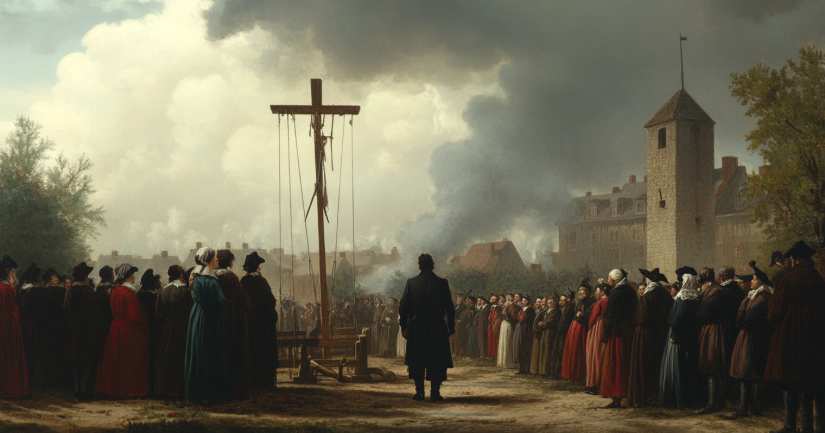
Expand your vocabulary and uncover the language of Salem with The Crucible Vocabulary Quiz: Master Key Terms from Arthur Miller’s Play. Arthur Miller’s famous play, The Crucible, uses specific words and phrases to strengthen the drama and historical realism. The Crucible Vocabulary Quiz challenges you to understand key terms clearly, making the play’s themes easier to grasp. By identifying essential vocabulary like “theocracy,” “hysteria,” “dissembling,” and “allegory,” you’ll better understand Salem’s moral struggles, character actions, and Miller’s message about society.
Salem was run as a theocracy, meaning religious leaders controlled the community. Miller emphasizes theocracy to highlight how strict religious control created fear and injustice in Salem. Understanding “theocracy” helps you clearly see how Salem’s strict rules caused paranoia, unfair trials, and suffering.
Mastering the language of The Crucible is impressive, but how well do you know its characters? Test yourself with The Crucible True Or False Quiz! If you want to explore key dialogue, try The Crucible Quote Identification Quiz. And for the biggest challenge, see if you can ace The Crucible Full Book Quiz!
Kick Off the The Crucible Vocabulary Quiz
Theocracy: When Religion Rules
When religious authority dictated justice, innocent people faced severe punishment. Clearly recognizing the term “theocracy” allows you to better understand Miller’s critique of mixing religion with politics and power.
Hysteria: Fear Out of Control
“Hysteria” describes how Salem’s panic quickly got out of control, leading to false accusations. Miller shows hysteria clearly through Abigail Williams’ accusations against innocent people. Understanding “hysteria” helps readers see how easily fear can spread and harm a community.
When characters like Elizabeth Proctor and Rebecca Nurse are falsely accused, readers clearly understand the destructive power of hysteria. Knowing this term enhances your grasp of Miller’s critical message about fear and mass panic.
Betrayal and Honesty: Crucial Terms
Words like “lechery” and “dissembling” clearly illustrate moral conflicts between characters. John Proctor struggles with guilt over “lechery” (adultery), which deeply affects his actions. Recognizing this term clearly explains Proctor’s emotional struggle with honesty, guilt, and integrity.
“Dissembling” means lying or hiding true intentions. Abigail Williams repeatedly dissembles to gain power, clearly showing readers how deception spreads harm. Understanding “dissembling” helps you grasp Abigail’s dangerous behavior, clarifying Miller’s warnings about dishonesty and manipulation.
Courtroom Terms: Understanding Salem’s Trials
Miller includes specific legal terms like “deposition,” “affidavit,” and “indictment” to clearly show courtroom injustice. A “deposition” is a written statement used in court, crucial in scenes involving John Proctor’s defense. Recognizing this vocabulary makes Miller’s courtroom drama easier to follow clearly.
An “indictment” simply means charging someone with a crime. Clearly knowing this term helps readers understand Salem’s trials and their injustice. Miller intentionally uses clear legal vocabulary to highlight the unfairness of Salem’s witch trials and their tragic outcomes.
Allegory and Symbolism: Clear Deeper Meanings
“Allegory” means using a story to represent real historical events symbolically. Miller clearly wrote The Crucible as an allegory for the McCarthy era in America, showing how fear destroys justice. Understanding allegory clearly helps readers connect Salem’s events with similar modern injustices.
Symbolism involves using simple objects to represent deeper ideas. Miller uses the poppet (doll) symbolically, clearly illustrating manipulation and betrayal. Recognizing symbolic vocabulary clearly reveals Miller’s deeper meanings behind ordinary items, enhancing understanding significantly.
Emotional Vocabulary: Fear, Anger, and Integrity
Miller carefully chooses emotional vocabulary like “paranoia,” “fear,” and “revenge” to communicate clearly characters’ feelings. Abigail’s paranoia and accusations show how fear easily controls a community. Clearly understanding these emotional terms deepens your connection to characters’ motivations and feelings.
Words like “integrity,” “probity,” and “penitence” emphasize moral courage. John Proctor’s struggle with integrity clearly shows how honesty requires bravery. Recognizing these terms helps readers clearly see Miller’s message about maintaining personal morals under pressure.
Why Take The Crucible Vocabulary Quiz?
Taking The Crucible Vocabulary Quiz helps students and literature fans clearly understand Arthur Miller’s powerful play. By mastering important words, you improve comprehension and analysis skills, making classroom discussions easier. Clear knowledge of vocabulary terms helps you interpret Miller’s characters, themes, and messages about society more deeply.
Each question clearly reinforces your understanding, helping you confidently grasp Miller’s drama, characters, and themes. Clearly identifying important vocabulary helps you engage deeply with Miller’s warnings about fear, injustice, and morality.
Ready to test your knowledge of important terms in The Crucible? Take The Crucible Vocabulary Quiz now and confidently master key words from Arthur Miller’s famous play.
Crucible Quizzes: Dive into the drama and betrayal …
The Crucible Vocabulary – FAQ
The Crucible is a play written by American playwright Arthur Miller in 1953. It dramatizes the Salem witch trials of 1692 and explores themes of hysteria, reputation, and integrity.
The vocabulary used in The Crucible is crucial for understanding the historical and cultural context of the play. Words like witchcraft, puritanical, and hysteria evoke the atmosphere of 17th-century New England and highlight the societal tensions that fuel the drama. Familiarity with these terms can deepen a reader’s comprehension and engagement with the text.
Key vocabulary words from The Crucible include crucible, afflicted, contention, vindictive, and abomination. These words reflect the intense emotions and moral conflicts that drive the characters’ actions and the plot’s progression. Understanding these terms can provide insight into the characters’ motivations and the play’s themes.
To effectively learn and remember the vocabulary from The Crucible, it is helpful to use a combination of strategies. Creating flashcards, using the words in sentences, and discussing them in study groups can reinforce understanding. Additionally, relating the words to modern-day examples or personal experiences can make them more memorable.
